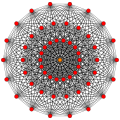| 331 honeycomb | |
|---|---|
| (no image) | |
| Type | Uniform tessellation |
| Schläfli symbol | {3,3,3,33,1} |
| Coxeter symbol | 331 |
| Coxeter-Dynkin diagram | |
| 7-face types | 321 {36} |
| 6-face types | 221 {35} |
| 5-face types | 211 {34} |
| 4-face type | {33} |
| Cell type | {32} |
| Face type | {3} |
| Face figure | 031 |
| Edge figure | 131 |
| Vertex figure | 231 |
| Coxeter group | , [33,3,1] |
| Properties | vertex-transitive |
In 7-dimensional geometry, the 331 honeycomb is a uniform honeycomb, also given by Schläfli symbol {3,3,3,33,1} and is composed of 321 and 7-simplex facets, with 56 and 576 of them respectively around each vertex.
YouTube Encyclopedic
-
1/2Views:2 92415 388
-
Yedid Nefesh (EDM Remix) [feat/prod by Yishai Revivo]
-
1950s Music, 1950s Music Oldies with 1950s Music Playlist and 1950s Music Videos Classics Mix
Transcription
Construction
It is created by a Wythoff construction upon a set of 8 hyperplane mirrors in 7-dimensional space.
The facet information can be extracted from its Coxeter-Dynkin diagram.
Removing the node on the short branch leaves the 6-simplex facet:
Removing the node on the end of the 3-length branch leaves the 321 facet:
The vertex figure is determined by removing the ringed node and ringing the neighboring node. This makes 231 polytope.
The edge figure is determined by removing the ringed node and ringing the neighboring node. This makes 6-demicube (131).
The face figure is determined by removing the ringed node and ringing the neighboring node. This makes rectified 5-simplex (031).
The cell figure is determined by removing the ringed node of the face figure and ringing the neighboring nodes. This makes tetrahedral prism {}×{3,3}.
Kissing number
Each vertex of this tessellation is the center of a 6-sphere in the densest known packing in 7 dimensions; its kissing number is 126, represented by the vertices of its vertex figure 231.
E7 lattice
The 331 honeycomb's vertex arrangement is called the E7 lattice.[1]
contains as a subgroup of index 144.[2] Both and can be seen as affine extension from from different nodes:
The E7 lattice can also be expressed as a union of the vertices of two A7 lattices, also called A72:
=
∪
The E7* lattice (also called E72)[3] has double the symmetry, represented by [[3,33,3]]. The Voronoi cell of the E7* lattice is the 132 polytope, and voronoi tessellation the 133 honeycomb.[4] The E7* lattice is constructed by 2 copies of the E7 lattice vertices, one from each long branch of the Coxeter diagram, and can be constructed as the union of four A7* lattices, also called A74:
∪
=
∪
∪
∪
= dual of
.
Related honeycombs
It is in a dimensional series of uniform polytopes and honeycombs, expressed by Coxeter as 3k1 series. A degenerate 4-dimensional case exists as 3-sphere tiling, a tetrahedral hosohedron.
| Space | Finite | Euclidean | Hyperbolic | |||
|---|---|---|---|---|---|---|
| n | 4 | 5 | 6 | 7 | 8 | 9 |
| Coxeter group |
A3A1 | A5 | D6 | E7 | =E7+ | =E7++ |
| Coxeter diagram |
||||||
| Symmetry | [3−1,3,1] | [30,3,1] | [[31,3,1]] = [4,3,3,3,3] |
[32,3,1] | [33,3,1] | [34,3,1] |
| Order | 48 | 720 | 46,080 | 2,903,040 | ∞ | |
| Graph | 
|

|

|
- | - | |
| Name | 31,-1 | 310 | 311 | 321 | 331 | 3<sub>41</sub> |
See also
References
- ^ "The Lattice E7".
- ^ N.W. Johnson: Geometries and Transformations, (2018) Chapter 12: Euclidean symmetry groups, p 177
- ^ "The Lattice E7".
- ^ The Voronoi Cells of the E6* and E7* Lattices Archived 2016-01-30 at the Wayback Machine, Edward Pervin
- H. S. M. Coxeter, Regular Polytopes, 3rd Edition, Dover New York, 1973
- Coxeter The Beauty of Geometry: Twelve Essays, Dover Publications, 1999, ISBN 978-0-486-40919-1 (Chapter 3: Wythoff's Construction for Uniform Polytopes)
- Kaleidoscopes: Selected Writings of H.S.M. Coxeter, edited by F. Arthur Sherk, Peter McMullen, Anthony C. Thompson, Asia Ivic Weiss, Wiley-Interscience Publication, 1995, ISBN 978-0-471-01003-6 [1] GoogleBook
- (Paper 24) H.S.M. Coxeter, Regular and Semi-Regular Polytopes III, [Math. Zeit. 200 (1988) 3–45]
- R. T. Worley, The Voronoi Region of E7*. SIAM J. Discrete Math., 1.1 (1988), 134-141.
- Conway, John H.; Sloane, Neil J. A. (1998). Sphere Packings, Lattices and Groups ((3rd ed.) ed.). New York: Springer-Verlag. ISBN 0-387-98585-9. p124-125, 8.2 The 7-dimensinoal lattices: E7 and E7*
- Klitzing, Richard. "7D Heptacombs x3o3o3o3o3o3o *d3o - naquoh".
| Space | Family | / / | ||||
|---|---|---|---|---|---|---|
| E2 | Uniform tiling | {3[3]} | δ3 | hδ3 | qδ3 | Hexagonal |
| E3 | Uniform convex honeycomb | {3[4]} | δ4 | hδ4 | qδ4 | |
| E4 | Uniform 4-honeycomb | {3[5]} | δ5 | hδ5 | qδ5 | 24-cell honeycomb |
| E5 | Uniform 5-honeycomb | {3[6]} | δ6 | hδ6 | qδ6 | |
| E6 | Uniform 6-honeycomb | {3[7]} | δ7 | hδ7 | qδ7 | 222 |
| E7 | Uniform 7-honeycomb | {3[8]} | δ8 | hδ8 | qδ8 | 133 • 331 |
| E8 | Uniform 8-honeycomb | {3[9]} | δ9 | hδ9 | qδ9 | 152 • 251 • 521 |
| E9 | Uniform 9-honeycomb | {3[10]} | δ10 | hδ10 | qδ10 | |
| E10 | Uniform 10-honeycomb | {3[11]} | δ11 | hδ11 | qδ11 | |
| En-1 | Uniform (n-1)-honeycomb | {3[n]} | δn | hδn | qδn | 1k2 • 2k1 • k21 |